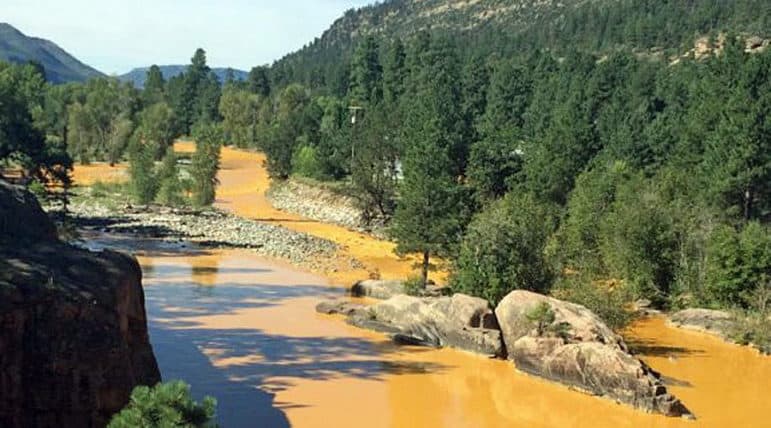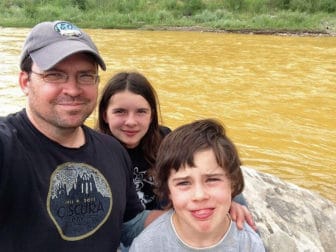
La Plata County / Courtesy photo
A scene from the Animas River in La Plata County, Colo., after last week’s spill.
Government officials from New Mexico and the Navajo Nation were among those working through the weekend to try to understand and respond to the Environmental Protection Agency’s inadvertent triggering of the spill of an estimated 3 million gallons of toxic waste into the Animas River last week.
Wired has a succinct summary of how we got here:
It’s a classic case of good intentions backfiring. The abandoned mines in the area have long been a problem, filling up with acidic wastewater that leaches heavy metals out of rock and leaks into the river—a slow-motion environmental debacle. And the EPA has been trying to designate the mines a Superfund site for years, only to come up against local resistance. The mines still aren’t on the Superfund list, but the EPA has been trying to them clean up anyway. That’s why a crew was digging around the Gold King Mine — they starting to investigate leaks when the mine’s plug blew, turning the slow-motion problem into a fast-moving, highly visible advertisement for fixing the problem. “It’s hard being on the other side of this,” said Dave Ostrander, the regional EPA director of emergency preparedness, at a public meeting on Friday afternoon. “We typically respond to emergencies; we don’t cause them.”
The spill occurred along the Animas River in Southwestern Colorado, which flows through Northwestern New Mexico near Aztec and into the San Juan River. The water then flows through the Navajo Nation as part of the Colorado River system that provides water to much of Arizona and Southern California.
Officials in New Mexico and the Navajo Nation have urged people to stay away from the rivers while the contamination flows through. Both governments are conducting their own tests to determine the severity of the disaster.
N.M. Gov. Susana Martinez said the EPA failed to notify the state about the spill for 24 hours. State officials are highly critical of the federal agency.
“We will not allow EPA to leave until they have compensated us,” N.M. Environment Department Cabinet Secretary Ryan Flynn said during a town hall meeting, according to the Farmington Daily Times.
New Mexico’s congressman representing that area, Democrat Ben Ray Luján, also criticized the EPA’s response during a weekend meeting, according to the newspaper.
“There’s a lot of questions that our constituents have, and so many communities have as well, that we need to get rapid responses to,” the Daily Times quoted him as saying.
Navajo Nation President Russell Begaye announced Sunday that the Navajo Nation was making cleanup plans and preparing lawsuits against the Gold King Mine, where the spill occurred, and the EPA.
“We are going to be suing for millions, billions of dollars,” the Navajo Times quoted Begaye as saying. “…We are going to make EPA pay for this.”
‘Thank you EPA’
Though many said the mine shares blame for the pollution, much of the anger in a discussion NMPolitics.net facilitated on Facebook was aimed at the EPA.
“Thank you EPA,” former state Rep. Kathy McCoy of Albuquerque wrote. “If a private company had done this, they’d be jailed and fined within minutes.”
“This is your crack government professionals at work,” wrote Mike Johnson of Santa Fe.
Not all were quick to express anger. “The EPA now must be completely open and hide nothing,” Michael Swickard of Las Cruces wrote. “I’m not mad that an accident did happen, but if the EPA gives us attitude or they BS us, I will be angry.”

Jim O'Donnell / Courtesy photo
Jim O’Donnell of Taos has been camping with his family in Colorado and took this photo alongside the polluted Animas River on Friday in Durango. “So sad. I’ve fished and rafted that river so much,” he told NMPolitics.net.
Many joined the Martinez Administration in expressing frustration about the EPA’s lack of information gathering and/or sharing about the spill.
Claudia Anderson of Farmington said the San Juan River runs along her property. She wrote on Facebook that her “biggest beef is the lack of timely information.” She was worried about wildlife.
“We keep part of the property wild as sanctuary, and I’ve got turkeys and deer and raccoons and heaven only knows what else who drink out of that river,” Anderson wrote.
Officials were scrambling, without solid information, to keep people and animals safe. Among Begaye’s words to people on the Navajo Nation, according to the Navajo Times: Stay out of the San Juan River. Keep livestock from drinking the water. Avoid using the river water.
The Durango Herald on Sunday published an article about “cause for optimism:” Days after the spill, there haven’t been massive fish or insect die-offs.
Effects ‘will be felt for months’
Later Sunday the EPA upped its estimate of the spill’s size from 1 million gallons to 3 million. And one thing is certain, the Durango Herald reported in a separate article:
The effects of the environmental disaster will be felt for months. The high-water mark left from the pulse of toxic waste deposited a yellow-orange film along large swaths of the Animas River. As the murky water traveled 50 miles from Silverton, it tumbled over rocks that kept it stirred. By the time it arrived in the Animas Valley near Dalton Ranch, the river slowed, which gave minerals a chance to settle on the riverbed. High-water run-off events are expected to stir those sediments and cloud the river during the weeks and months to come.
And from Wired:
The EPA is working to stop the flow into the river by building a retention pond next to the mine. But the contaminants already in the water? There’s nothing to do — except wait for the muck to sink or dilute down. The Bureau of Reclamation is releasing more water from the Navajo Dam to dilute the toxic metals. But spring runoff next year might stir up contaminants that have sunk to the river bottom all over again.
Carol Miller of Ojo Sarco wrote on Facebook that the spill is a symptom of a larger problem.
“The real cause of this was the company or companies that mined and profited from the ore and walked away from the mess, not even attempting remediation,” she wrote. “The heavy metals sink to the bottom and the river and stream banks even as the contamination is diluted. Every time there are rains, snowmelt and/or high water the toxins will be re-suspended. This is a long-term disaster that isn’t over when the river again runs clear.”
Video
Here’s video from the Durango Herald of the contamination flowing into the river:
